七年级英语新目标上unit2period5PPT课件
642kj_新目标七上Unit 2 PPT课件1
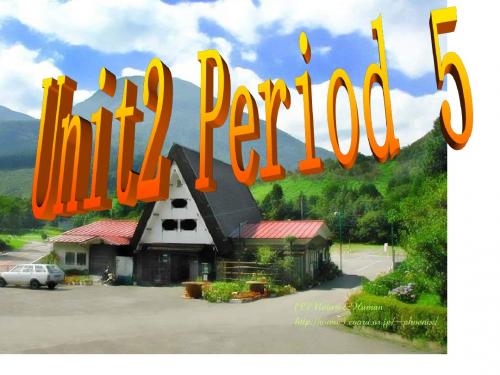
your Is this ______(you) pencil? Yes, ____ ____. it is
Is this your you ) book? ____( it is Yes,___ ____. my This is ______ ( I ) book.
his this Is _____ ______( he ) book? Yes ______,it is.
中国教考资源网
A: Is this your …? B: Yes, it is. It’s my…. No, it isn’t. It’s his…. No, it isn’t.It’s her….
This is a pencil. Is this a pencil
This is my pencil. Is this your pencil
Yes,it is. No,it isn’t.
Is this your pencil?
Yes,it is.
Is this your pencil?
No, it isn’t. It’s her ruler.
A C
B
A C
B D
积极主动参与小组 活动,在活动中起 主导作用
A C
B D
A C
B D
A C
B
A C
B D
学生知识掌握自我评价表
I can 1.tell the names of things. the school things. 2.read and spell the words lesson. in the lesson. 3.write the words I learnt lesson. in the lesson. 4.ask and answer: answer: Isthis/thatyour/her/his…? Isthis/thatyour/her/his ? 5.ask and answer: answer: What’sthis/that What sthis/that in English? 6.understand the listening materials. 7.read and understand the bulletin board notices. 8.write simple lost and found notices.
人教版(新目标)七年级上Unit2 Section A(2d–3c)课件
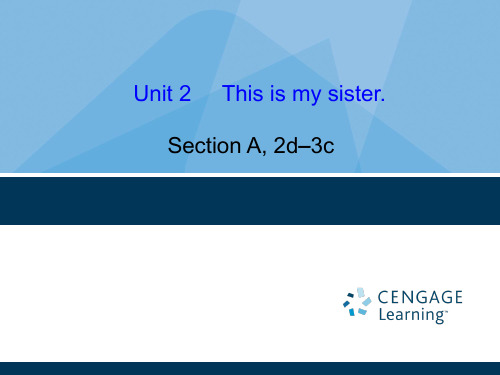
Explanation 解释
1. …, this is my sister Kate. 这是我的妹妹凯特。 my sister Kate是同位语
2.Oh, I see. 噢,我明白了。
3. Well, have a good day! 那好,愿你们(一天)玩得高兴!
4. Thanks! You, too. 多谢了!也祝你玩得高兴。
3b Look at the picture. Make sentences with the words in the three boxes.
Is/are
father
this that these those
mother
grandfather my grandmother your parents
mother.
B: __W__h_o_’_s_ he? A: ___H_e_’_s__ my father. B: Who’s __s__h_e____? A: She’s __m__y_____ sister. B: And _w__h_o_’_r_e__ they? A: _T__h_e_y_’_r_e_ my grandparents.
2d Role-play the conversation.
Sally: Good morning, Jane. Jane: Good morning, Sally. Sally: Oh, Jane, this is my sister Kate. Kate, this is my friend Jane. Kate: Nice to meet you, Jane. Jane: Nice to meet you, too. Are those your parents? Kate: Yes, they are. Jane: And who’s he? Sally: He’s my brother, Paul. Jane: Oh, I see. Well, have a good day! Sally/Kate: Thanks! You, too. Bye!
七年级英语上册Unit2 Period 5教案(鲁教版五四制)
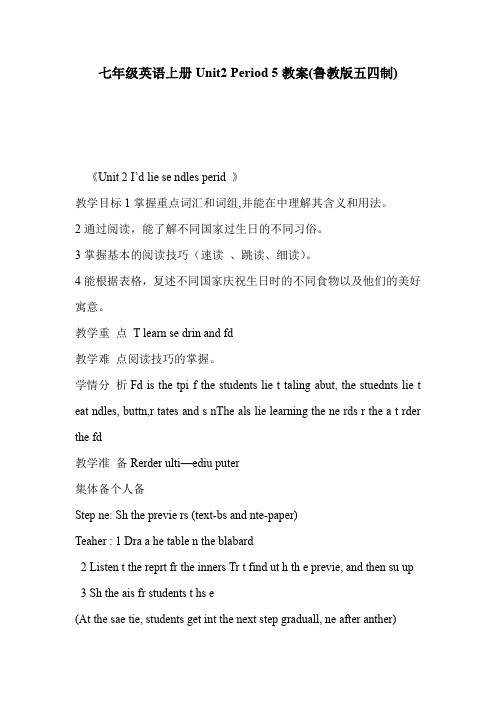
七年级英语上册Unit2 Period 5教案(鲁教版五四制)《Unit 2 I’d lie se ndles perid 》教学目标1掌握重点词汇和词组,并能在中理解其含义和用法。
2通过阅读,能了解不同国家过生日的不同习俗。
3掌握基本的阅读技巧(速读、跳读、细读)。
4能根据表格,复述不同国家庆祝生日时的不同食物以及他们的美好寓意。
教学重点T learn se drin and fd教学难点阅读技巧的掌握。
学情分析Fd is the tpi f the students lie t taling abut, the stuednts lie t eat ndles, buttn,r tates and s nThe als lie learning the ne rds r the a t rder the fd教学准备Rerder ulti—ediu puter集体备个人备Step ne: Sh the previe rs (text-bs and nte-paper)Teaher : 1 Dra a he table n the blabard2 Listen t the reprt fr the inners Tr t find ut h th e previe, and then su up3 Sh the ais fr students t hs e(At the sae tie, students get int the next step graduall, ne after anther)Step T: Learn b theselvesStudents: 1 Deide n ais2 Self-stud:1) Read th e text again, and rret ur istaes;2) Disuss ur prbles in grups3 As ther grups fr helpTeaher: Instrutins abut the diffiulties1Anser 1n(名词)2v(动词)2、The nuber fA nuber f3、It ’s getting ppular t have a ae n ur birthdaIt为形式主语。
新目标英语七年级上册 (2)
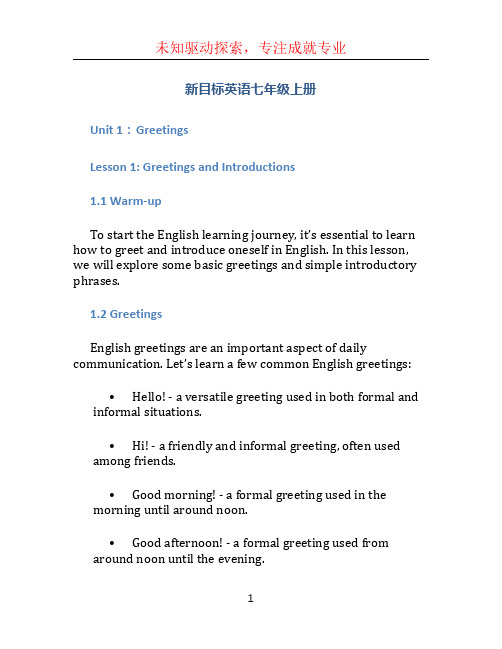
新目标英语七年级上册Unit 1:GreetingsLesson 1: Greetings and Introductions1.1 Warm-upTo start the English learning journey, it’s essential to learn how to greet and introduce oneself in English. In this lesson, we will explore some basic greetings and simple introductory phrases.1.2 GreetingsEnglish greetings are an important aspect of daily communication. Let’s learn a few common English greetings:•Hello! - a versatile greeting used in both formal and informal situations.•Hi! - a friendly and informal greeting, often used among friends.•Good morning! - a formal greeting used in the morning until around noon.•Good afternoon! - a formal greeting used from around noon until the evening.•Good evening! - a formal greeting used in the evening and at night.1.3 IntroductionsNext, let’s learn how to introduce ourselves in English. Here’s an example of a basic self-introduction:•A: Hello! My name is Alice. What’s your name?•B: Hi Alice! Nice to meet you. I’m Bob.In English, when introducing oneself, it is essential to include your name and greet the other person. It’s also customary to respond by offering a pleasant response when someone introduces themselves to you.1.4 PracticeTo reinforce the learning, let’s practice greetings and introductions. Role-play different scenarios with your classmates or use the following questions as prompts:•What’s your name?•How old are you?•Where are you from?Remember to use appropriate greetings and polite language during these interactions.1.5 Speaking ChallengeFor the speaking challenge, choose a partner and practice exchanging introductions. Make sure to greet each other and ask questions using the phrases you have learned.Lesson 2: Classroom English2.1 Warm-upIn this lesson, we will learn essential classroom English phrases that will help you communicate effectively with your teachers and peers.2.2 Classroom InstructionsTo ensure smooth classroom activities, teachers often use specific instructions in English. Let’s familiarize ourselves with some common classroom instructions:•Please sit down.•Raise your hand.•Stand up.•Open your book.•Close your book.•Pay attention.•Take out your pen/pencil.•Put away your belongings.2.3 Expressing NeedsWhen you need something in the classroom, it’s important to know how to express your needs. Here are some useful phrases:•Can I borrow a pen, please?•May I go to the restroom?•I need a piece of paper.•Can you help me, please?•I don’t understand.2.4 PracticeTo practice classroom English, engage in role-playing activities with your classmates. Act out different classroom scenarios and use the classroom instructions and phrases you have learned.2.5 Speaking ChallengeFor the speaking challenge, pair up with a classmate and take turns giving instructions or expressing needs. Practice using the phrases from this lesson and respond accordingly.Unit 2: My School LifeLesson 3: Daily Routines3.1 Warm-upIn this lesson, you will learn how to talk about your daily routines in English. Daily routines refer to the regular activities you engage in every day, such as waking up, eating breakfast, going to school, etc.3.2 Talking about Daily RoutinesTo talk about daily routines, we use time expressions and action verbs. Here are some examples:•I wake up at 7 am.•I brush my teeth.•I have breakfast at 7:30 am.•I go to school at 8 am.3.3 Adverbs of FrequencyWhen discussing daily routines, we often mention how frequently we perform certain actions. Adverbs of frequency help us express this. Here are some common adverbs of frequency:•Always•Usually•Often•Sometimes•Rarely•Never3.4 PracticeTo practice talking about daily routines, create a schedule for an average school day. Include the time and actions you typically perform. Share your schedule with a partner and discuss similarities and differences.3.5 Speaking ChallengeFor the speaking challenge, create a dialogue with a classmate where you discuss your daily routines. Incorporate the adverbs of frequency and time expressions into your conversation.Unit 3: My FamilyLesson 4: My Family4.1 Warm-upIn this lesson, we will learn vocabulary related to family members and how to describe them in English.4.2 Family VocabularyLet’s start by learning some common family member vocabulary:•Mother•Father•Sister•Brother•Grandmother•Grandfather•Aunt•Uncle•Cousin4.3 Describing Family MembersOnce you have learned the family member vocabulary, practice describing your family members using simple sentences. For example:•My mother is kind and caring.•My sister is funny and creative.•My grandfather likes to tell stories.4.4 PracticeTo reinforce your understanding and vocabulary, create a family tree. Include the names of your family members and describe their characteristics using adjectives.4.5 Speaking ChallengeFor the speaking challenge, create a presentation about your family. Introduce each family member and describe their personality traits. Use the vocabulary and sentence structures you have learned in this lesson.ConclusionIn this document, we have covered the first three units of the New Target English Grade 7 textbook. These units focused on greetings, classroom English, daily routines, and family vocabulary. By practicing these essential topics, you will be equipped with basic English communication skills that will serve as a foundation for further learning. Keep practicing and exploring the English language!。
人教版教学课件:新目标英语七年级上册Unit-2-This-is-my-sister-Sectio

句型转换 根据要求,完成下列句子。
1.Those are my cousins.(改为一般问句) ____A_r_e_t_h_o_s_e _y_o_u_r _c_ou_s_i_n_s?______.
2.This is my sister.(改为复数) ____T_h_e_s_e_a_r_e_m_y__si_s_te_r_s._______.
sister son cousin grandpa mom aunt grandpa / grandma
dad /_m__o_m_
daughter
(_s_i_st_e_r_)
__s_o_n__ (brother)
uncle/_a_u_n_t (3)
daughter (_c_o_u_s_in_)
1b Listen and check (√ )the words
根据括号中的汉语提示写单词。
1.Frank is John’s ___s_o_n___ (儿子). 2. Grace is my __c_o_u_s_in__ (表妹). 3. His d__a_u_g_h_te_r(女儿) is a good girl. 4. He is not my ___u_n_c_le_ (叔叔). 5. The _p_i_c_tu_r_e__/ _p_h_o_t_o_ (照片) is nice.
表兄(弟、姊、妹)
mother father
书面语
parents
mom dad
口语
grandmother
grandma
grandparents
grandfather
grandpa
书面语
口语
New Words
aunt n. 姑母;姨母;伯;伯父;
七年级英语上册第五单元课件

I have a basketball. 肯定句 ?
Do you have a basketball?一般疑问句
仔细观察,小组讨
Yes,
I
do.
论,这个句子是怎 样由肯定句变成一
No, I don’t.般(d疑o问n句o呢t ?= don’t)
肯定句变成一般疑问句时,要借助于助动词___d_o____, 放在句首;第__一___人称变第__二___人称;__句___号 变__问__ 号;语调用__升___调____。
用于构成否定句和一般疑问句
basketball
/ɑ :/ / I /
tennis ball
/e/ / I /
baseba仔l细l 观察,小组p讨ing-pong ball
/ei/ 论,你能说出这/ 些I / /ɒ/
baseb红a组l色l合字b/的æa母发t/或音者吗字v?母/oɒl/leyball
• 2.句型:I/We/They have a/an….
• He/she has a/an…..
• --Do you have…?—Yes,I do. /No, I don’t.
• --Does she/he have…?---Yes,she/he does.
• /No,she/ he doesn’t. • 3.掌握have和has的区别. • 4.理解听力内容.
Do you have a soccer ball?
√
Yes, I do. I have a soccer ball.
ping-pong bat
Do you have a ping-pong bat?
×
No, I don’t.
I don’t have a ping-pong bat.
沪教版七年级英语上册Unit 2 Daily life -Period 5 公开课PPT课件
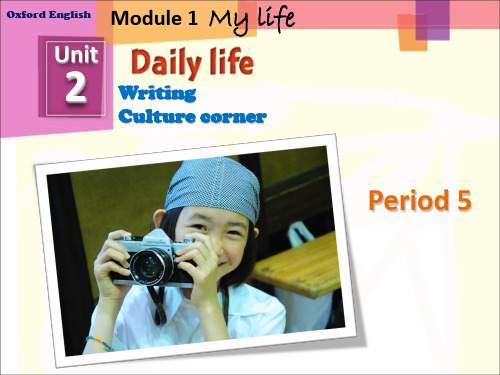
6:30 a.m. 7 a.m. 7:30 a.m.
get up have breakfast go to school
4–4:30 p.m. 4:45 p.m. 6:30 p.m.
play basketball with friends (twice a week) go home have dinner
She sometimes watches TV in the evening. goes to bed at 9 p.m. She always (8)____________________.
Work in pairs and list your daily schedule.
Time Activity
8:30 a.m. – 4 p.m.
have classes
9 p.m.
go to bed
While-writing
Describe the schedule. Follow the example.
6:30 a.m. 7 a.m. get up have breakfast 4–4:30 p.m. 4:45 p.m. play basketball with friends (twice a week) go home
Many people around the world keep a diary. They write in it every day.In a diary, you can write about your daily life. People often start by writing “Dear Diary”. They think of the diary as a friend.
Homework
人教新目标版七年级英语上册教学课件:Unit 2 period 5
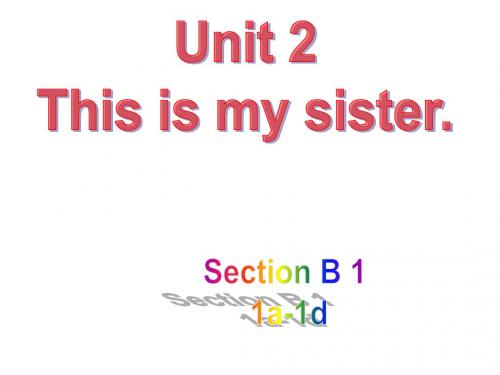
Family Tree
grandfather/grandpa grandmother /grandma
father/dad son brother I
mother/mom uncle
aunt daughter
cousins sister
2a Find the male and female first names in this unit and write them. Male
2b Read about Jenny’s family and circle the names.
My Family
Hi, I’m Jenny. Here are two nice
photos of my family. My grandfather
and grandmother are in the first photo.
Jiang Tao, Tom, Bob, Jack, Alan, Eric, John, Paul, Bill, Dale.
female
Cindy, Mary, Linda, Jenny, Jane, Kate, Helen, Sally, Li Lan, Jiang Shan.
1. Group the words for family members you have learned.
3. Jenny is my dad’s sister. She’s my _____. A. aunt A. dogs B. uncle B. girls C. cousin C. boys 4. Those two ________ are my sisters.
II. 选词填空。 son, photo, daughter, girl, of, next 1. Here’s a photo _____ of Mary’s family.
七年级-人教版(2024新版)-英语-上册-【课件】-My-School-(Period-5)
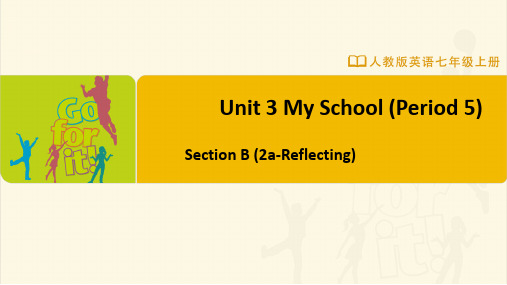
our books …
Pair work
A: Are there any ...? B: Yes, there are. / No, there aren’t.
A: Is there a / an ...? B: Yes, there is. / No, there isn’t.
Pair work
书写电子邮件 的常用表达
(1) Thanks / Thank you for your email / writing to me / your writing. (2) Bye for now. / Please write to me soon. …
Suppose your friend Tina from another school has sent you an email asking about your favourite places and the activities you like best in your new school. Write a reply to her.
正文部分
Common expressions to use when writing an email
新目标七年级上Unit2 period 1精美ppt课件
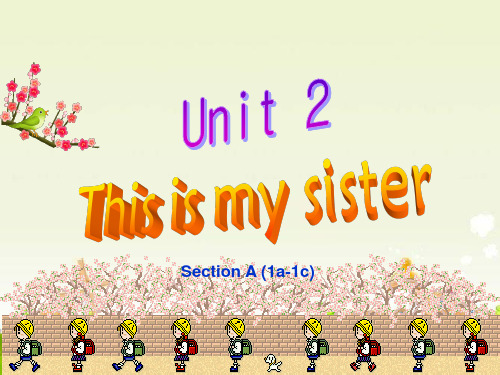
This is my brother Liu Xing. This is my brother Xia Yu.
My name is Xia Xue.
These are my two brothers.
My name is Xia Xue. This is my…These are my…
That is my…Those are my…
This is his grandmother.
This is his mother.
This is his father.
These are his parents.
That is his grandmother.
That is his grandfather.
T (1a-1c)
This is Liu Xing. This is his family.
This is his mother.
This is his father.
This is his brother.
This is his sister.
This is his grandfather.
Who's she?
This is Mary.
parents grandparents
brothers
一、按要求完成下列各题。
1.this(对应词) that 2.those(对应词) these 3.father(对应词) mother 4.sister(对应词) brother 5.parent(复数形式) parents 6.is(复数形式) are
mothperarenftasther grandgfraathnedrpgarraenndmtsother
人教新目标七年级上册 Unit 2 This is my sister.Period 4 (共15张PPT)
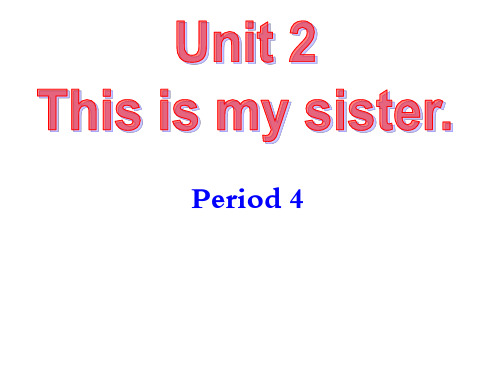
Hi! I am Tom. Here is my family photo. These are my grandparents. This is my father. This is my mother. These are my uncle, Tom, and aunt, Lucy. I have two brothers, Tony and Jim. Who is this boy? It’s me! I have a happy family. I love my family very much.
these two girls
这两个女孩
2c Read and complete the sentences.
1. My name is __J_e_n_n_y___. 2. Alan and Mary are my __p_a_r_e_n_ts___. 3. Bob and Eric are my __b_r_o_t_h_e_r_s__. 4. Cindy is my ___s_i_s_te_r___. 5. Helen is my ___c_o_u_s_i_n___. 6.____C_o_c_o____ is the name of my dog.
4. —咪咪是你的猫的名字吗?—不是。 —Is Mimi the n_a_m__e_ _o_f your cat? —No, _it_ isn’t.
5. 你的祖父母在下一张照片中吗? 是的。
—_A_r_e_ your _g_ra_n__d_p_a_r_en__ts_ in the _n_e_x_t picture?
根据汉语提示,完成句子。 1. 这里有一张我的家庭照片。
Here _is_ a photo _o_f my f_a_m__il_y. 2. 这是我的舅舅和舅母。
- 1、下载文档前请自行甄别文档内容的完整性,平台不提供额外的编辑、内容补充、找答案等附加服务。
- 2、"仅部分预览"的文档,不可在线预览部分如存在完整性等问题,可反馈申请退款(可完整预览的文档不适用该条件!)。
- 3、如文档侵犯您的权益,请联系客服反馈,我们会尽快为您处理(人工客服工作时间:9:00-18:30)。
sister
father’s muonthceler’s cosuosnin’s munoctlhee’r s daughter
grandmother/grandma
cousin aunt cousin
mother’s son brother
Family tree
grandfather
grandmother
Self Check 自查
1. Group the words for family members you have learned.
male
both
female
father dad
parents mother mom aunt sister
brother uncle grandparents grandmother
Unit 2 This is my sister
period5 Section B (2a-3b) and Self Check
father’s
grandfather/Байду номын сангаасrandpa
father father’s
uncle
mother’s daughter
bfartohtehre’r s sister aunt
two nice photos of my family 两张我家人的
漂亮照片
in the first photo 在第一张照片中 in the next picture 在下一张照片中
in my family
在我家
the name of my dog 我的狗的名字
3a Complete the passage with the words in the box. Then draw a picture of Paul’s family.
brothers parents Cindy family
Hi! My name is Paul. This is a photo of my __fa_m__il_y____. These are my __p_a_r_e_n_t_s____ and these are my ___b_r_o_t_h_e_rs____, John and Bob. This is my sister __C__in_d_y____.
Read the passage again and answer the questions.
1.Who is Alan? 2. Jenny’s father. 2. What’s the name of Jenny’s mother?
Mary. 3. Who are Bob and Eric?
Jack Eric Paul
Jenny Linda Kate Jane Helen Cindy
Before reading 读前
Who are they?
While reading 读中
2b Read about Jenny's family and circle the names.
Hi, I’m Jenny. Here are two nice photos of my family. My grandfather and my grandmother are in the first photo. These are my parents, Alan and Mary. In the next picture are my brothers, Bob and Eric. These two girls are my sister Cindy and my cousin Helen. Coco is in my family, too.
grandfather grandpa son
cousin
grandma
daughter
Self Check 自查
2. Complete the conversation.
Bill: Here’s a photo of my family. Dale: _W__h_o_’__she? Bill: __H_e_’__s my uncle. Dale: __W_h__o_’_sthis girl? Bill: _S_h__e_’_s__ my cousin. Dale: Are _t_h_o_s_e_ your parents? Bill: Yes, _th__e_y_ are. And these _a_r_e_ my grandparents.
father me daughter
mother
aunt
uncle
son
cousin cousin
sister brother
2a Find the male and female first names in the unit and write them.
Male
Female
Bob Tom John
After reading 读后 2c Read the passage again and complete the sentences.
1.My name is __J_e_n_n_y___. 2.Alan and Mary are my __p_a_r_en_t_s___. 3.Bob and Eric are my ___b_ro_t_h_e_rs___. 4.Cindy is my ____si_s_te_r___. 5.Helen is my ___c_o_u_s_in____. 6.____C_o_c_o____ is the name of my dog.
3b Show your family photo and write about it.
Hi. I am Sally. Here is my family photo. These are my grandparents. This is my father. This is my mother. These are my uncle, Tom, and aunt, Lucy. I have two brothers, Tony and Jim. Who is this boy? It’s me! I have a happy family. I love them all.
They are Jenny’s brothers. 4. Is Cindy Jenny’s sister?
Yes, she is. 5. What is the name of Jenny’s cousin?
Helen. 6. Is Coco a boy?
No. A dog.
Key phrases 重点词汇
